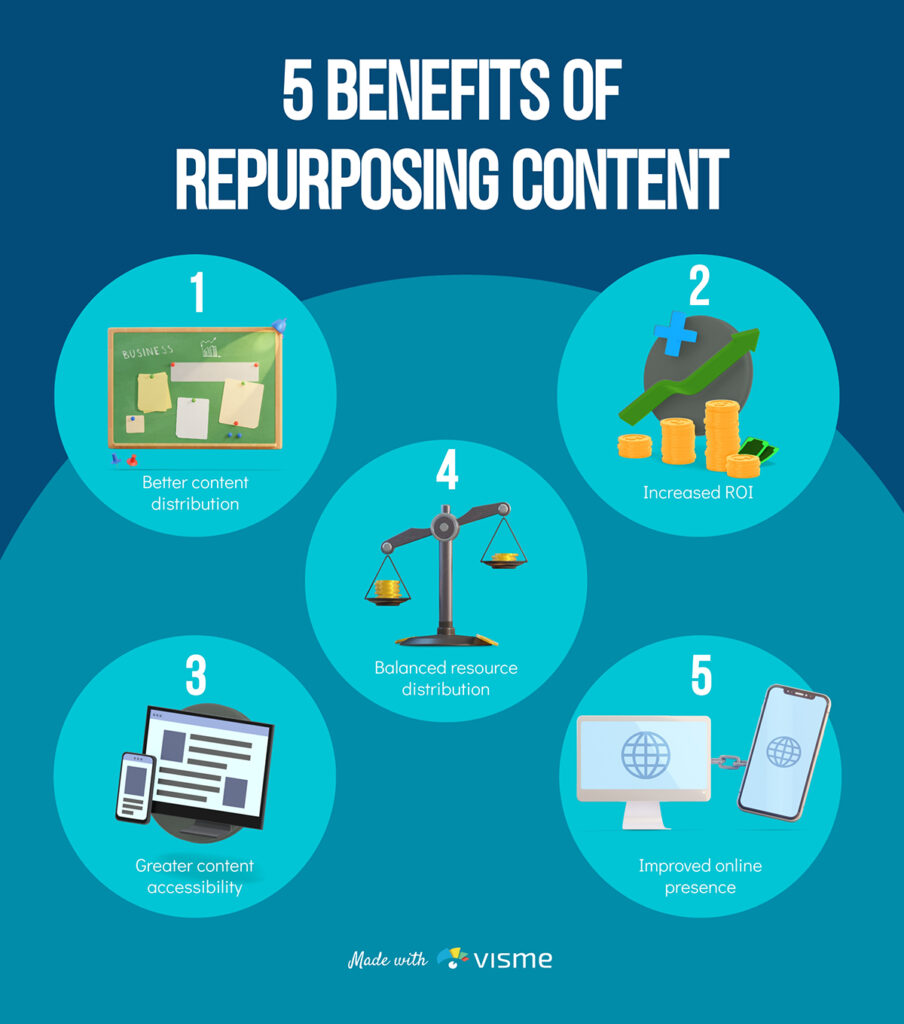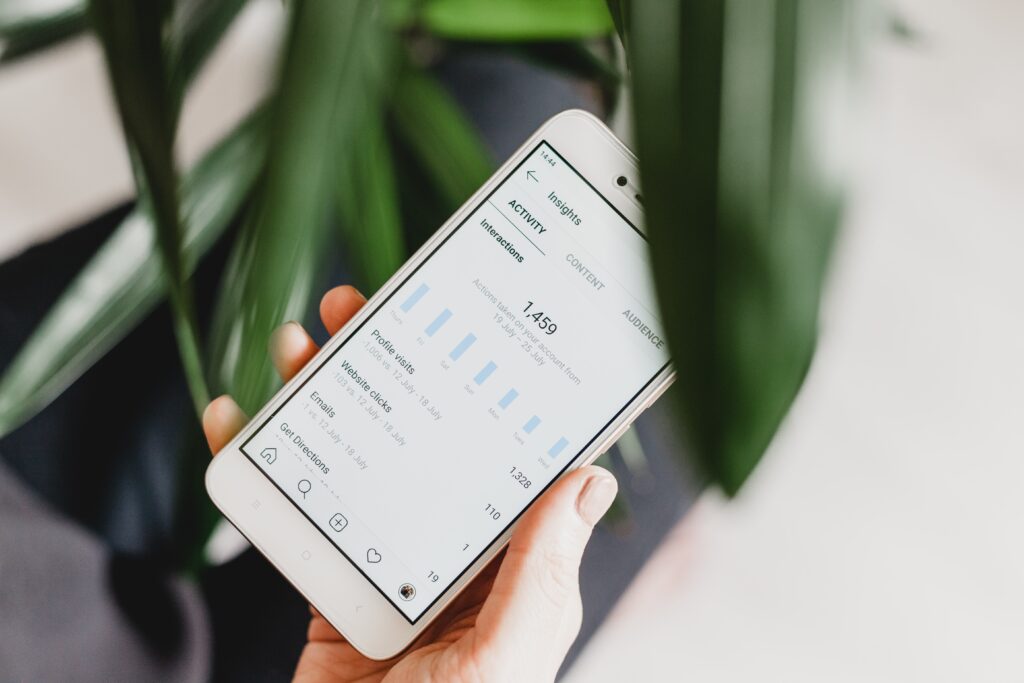Table of Contents
Nowadays, information is constantly flowing, and attention spans are fleeting. However, marketers face the challenge of reaching their target audiences. Enter the art of repurposing content—a strategic approach that empowers marketers to extend the reach and impact of their content. In this article, we’ll learn how to repurpose content and uncover practical strategies marketers can employ to breathe new life into their existing content.
Repurposing content is not merely a time-saving tactic; it’s a powerful strategy that can amplify your brand’s voice, engage diverse audiences, and bolster your online presence. Think of it as a dynamic way to recycle, transform, and reimagine your content to resonate with various platforms, formats, and audiences. By understanding the nuances of repurposing and mastering its techniques, you can harness the ability to connect with a broader range of individuals while maximizing value.
Check out this blog to learn more about how to create engaging Instagram carousel content!
Why Should You Repurpose Content?
The concept of repurposing content emerges as a beacon of ingenuity for marketers. Despite repurposing content not being new, imagine breathing new life into your meticulously crafted blog posts, videos, and infographics and extending their shelf life. This isn’t just about recycling old content; it’s about optimizing, reimagining, and strategically targeting diverse audiences.
The benefits of repurposing content are multi-faceted and potent. Firstly, it offers a cost-effective way to maximize your content creation efforts’ return on investment (ROI). Instead of perpetually churning out fresh ideas, you can extract more value from existing content by transforming it into various formats tailored to different platforms. This not only saves time but also capitalizes on the potential of your material.

Secondly, repurposing content significantly expands your reach. A single piece of content can be disseminated across many channels, spanning social media, podcasts, email campaigns, and more. This multi-channel approach ensures that your message resonates with a wider array of audiences, each with their preferred consumption mode. The more touchpoints your content has, the greater the chances of capturing the attention of potential customers who might have otherwise slipped through the cracks.
Learn about the different forms of traffic, like social and organic, at this NeoReach blog!
Identifying Opportunities to Repurpose Content
Before attempting to repurpose content, having a discerning eye for identifying the right candidates is crucial. Not all pieces of content are created equal, and not all will seamlessly transition into new formats. Here’s how you can pinpoint prime repurposing opportunities:
- Evaluate Engagement: Analyze your content library for pieces that have already struck a chord with your audience. Look for articles, videos, or infographics that have garnered high engagement, shares, and positive feedback. These are strong indicators that the content resonates with your target audience and has the potential to be repurposed successfully.
- Evergreen Content: Evergreen content remains relevant and valuable over time and is a goldmine for repurposing. Identify evergreen topics that are still pertinent to your audience, even if the original piece was published months or even years ago. By updating and adapting these timeless gems, you can extend their lifespan and continue to provide value to new and existing audiences.
- High-Performing Keywords: Leverage keyword research to identify content that ranks well in search engine results. This content is already attracting organic traffic, and by repurposing it into different formats, you can increase its visibility and reach.
- Complex Concepts: Content that explains complex concepts, processes, or ideas can often be broken down into more digestible formats. Consider transforming in-depth articles or guides into step-by-step tutorials, infographics, or video demonstrations, catering to different learning styles and preferences.
- Addressing Knowledge Gaps: Review your content analytics to identify gaps in your audience’s knowledge or questions they frequently ask. Repurposing content to address these gaps can position your brand as an authoritative source and provide valuable solutions to your audience’s pain points.

Tailoring Content for Different Platforms
As you begin repurposing content, remember that each platform has its unique language, tone, and audience behavior. Here’s how to navigate this art with finesse:
- Platform-Specific Adaptation: Approach each platform as an opportunity to tell your story in a way people remember. For instance, on social media platforms like Twitter, craft concise and attention-grabbing posts with relevant hashtags, while on LinkedIn, you can delve into more detailed insights.
- Visual Appeal: Leverage the visual dynamics of each platform to enhance engagement. Platforms like Instagram thrive on visually stunning images, while YouTube and TikTok are havens for video content. Adjust your repurposed content to align with the visual preferences of each platform’s users.
- Timing and Frequency: Pay attention to the timing and frequency of your posts. Research and analyze when your target audience is most active for optimal engagement.
- Storytelling Techniques: Adapt your content to fit the storytelling conventions of each platform. On Instagram Stories, use short video clips and interactive features. For website blogs, delve into comprehensive explanations and in-depth analysis.
- Engagement Strategies: Tailor your calls to action (CTAs) and engagement strategies based on the platform’s features. Encourage likes, shares, and comments on social media while on email campaigns, direct readers to your website or encourage them to download resources.
- Consistency and Branding: Maintaining consistency in your brand voice and messaging while adapting content. Whether it’s a witty tweet, an informative LinkedIn post, or a visually appealing Instagram image, ensure your brand’s identity shines.
Looking to boost your Instagram engagement rates? Take a peek at this NeoReach blog to learn how!
Refreshing and Updating Content
Content can quickly become outdated, losing its relevance and appeal. As you repurpose content, ensure that your content is relevant to your audience. Here’s how to breathe new life into your repurposed content:
- Timely Updates: Before repurposing, meticulously review the content for accuracy, particularly if it references data, statistics, or trends. Update any outdated information with the latest facts and figures, ensuring that your repurposed piece remains a reliable source of information.
- Fresh Perspectives: Infuse your repurposed content with new perspectives and insights. As your industry evolves, your own understanding deepens, and trends shift, you’ll have the opportunity to provide additional context and fresh viewpoints that enrich the content.
- Incorporate Recent Examples: Integrate recent case studies, success stories, or real-world examples to illustrate your points. These concrete examples enhance the credibility of your content and make it relatable and actionable for your audience.
- Address New Challenges: Identify emerging challenges or concerns within your industry and address them in your repurposed content. Your content will resonate more strongly with your audience by offering solutions to current pain points.
- Visual Makeover: Consider updating or editing images, graphics, or visuals to align with current design trends or better convey your message. A visual makeover can make repurposed content appear more modern, engaging, and appealing to your audience.
- User-Generated Content: If applicable, incorporate user-generated content such as customer testimonials, reviews, or success stories. This adds authenticity and showcases the real-world impact of your products or services. Consumers trust referrals from people and creators they know over traditional forms of marketing.
Check out this blog for user-generated content (UGC) examples done right!
Conclusion
The art of repurposing emerges as a strategic beacon for savvy marketers. Hopefully, this guide taught you how to repurpose content maximize impact, reach diverse audiences, and optimize resources.
Content repurposing is more than a time-saving strategy; it’s a versatile tool that transforms your creations into various formats. You can captivate audiences across diverse channels by identifying repurposing opportunities, tailoring content for specific platforms, and infusing visual elements.























